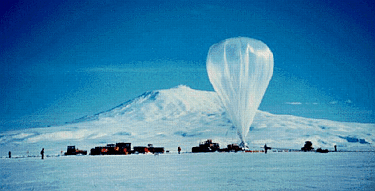
Experiments such as these helped pave the way for current satellite missions like ROSAT and CGRO. With a reduced number of satellite opportunities and the emphasis on reducing the size and cost of these missions, reliance on a strong balloon program becomes even more important. For example, gamma-ray instruments tend to be relatively heavy to attain a high efficiency to image weak sources. Consequently, unless the satellite version of the experiment can be conducted on a MIDEX or smaller mission, some vital X-ray or gamma-ray observations may never be conducted from satellites because of the mass constraint. There are numerous astrophysics experiments that can be inexpensively and quickly carried out on heavy lift balloons. Experience with operations in the Southern Hemisphere with long-duration balloon flights of two- to four-week duration clearly demonstrates the capabilities of the balloon platform for long flights. High-energy astrophysics would benefit greatly from further development of Southern Hemisphere long duration flight balloon operations and extension of this capability to the Northern Hemisphere.

Figure 3.4 - Launch of the UC Berkeley Ge spectrometer array in Antarctica. This flight lasted ~10 days. Mount Erebus is visible in the background.
The following specific points should be considered in assessing the value of long duration ballooning to high-energy astrophysics.:
3.7 THEORY
As the sensitivity and resolution of NASA's astronomy missions improve,
so too must the realism of the theory used to interpret the results and
give them meaning. Progress in theory accompanies the progress in experiment.
One cannot lead the other for long. Theory is both interpretive and predictive.
On the one hand, for data that are relatively well understood, theory builds
models to extract the greatest amount of information possible from them.
From these models emerge new predictions that can be tested and improved
until the phenomenon can be satisfactorily understood. On the other hand,
measurements may uncover surprises that generate great controversy and,
if properly understood, offer potential for scientific advancement. It
is such phenomena that pose the greatest challenge to theory and require
it the most. Many examples of each category could be given. We present
just two: nucleosynthesis gamma-ray lines and gamma-ray bursts.
It is widely
accepted that the elements heavier than helium are made in stars with supernovae
playing a major role. It is also well documented by measurement and understood
in theory that the short time scales and high temperatures of supernovae
lead to the creation of short and intermediate lived radioactive isotopes.
The species 26Al, 44Ti, 56Co, and 57Co have been detected and studied.
The role of theory is to obtain quantitative agreement between physical
models and the line measurements in terms of flux, line shapes, and angular
distributions. This then leads to constraints on models of stellar evolution
and supernovae and a better understanding of their nature; improved accuracy
in our models for galactic chemical evolution; and a better depiction of
massive star formation in our galaxy. Based upon these improved models,
theory makes predictions that can be confirmed by subsequent measurements,
e.g., a detectable signal from 60Fe.
Gamma-ray bursts represent science
of a different sort. Although the puzzle has made good headlines for a
decade or two, ultimately the goal of science is understanding. Here the
theorist is much less constrained, but also highly challenged by an unexpected
and poorly understood phenomenon. Quick, qualitative speculations are useful
for a time, but ultimately progress requires that speculation be backed
up by detailed physical analysis and simulations. Frequently these simulations
lead to the death of the model, but that too is progress. Eventually a
model, or set of models, will be found that explains what is observed and
makes predictions that can be confirmed. Meanwhile theory guides observations
in defining the sensitivity of future missions required to see bursts from
the halo from Andromeda, for example, or whether X-ray absorption lines
should be visible in the spectra of cosmological gamma-ray bursts. Three
dimensional general relativistic calculations of neutron star merger can
show whether or not relativistic beams can emerge. Calculations of planetesimal
accretion on neutron stars in the halo reveal that tidal disruption will
likely prevent the intact arrival of an object at the neutron star. Some
models predict a large number of hard X-ray bursts for every gamma-ray
burst; others predict that enduring hard GeV emission should be a common
characteristic, etc. All these predictions can and must be refined and
eventually tested.
New observations will drive theory as they always do.
It is important however that NASA continue to provide support to theory
particularly during these times of constrained budgets. For a comparatively
modest investment, NASA ensures the existence of a cadre of trained specialists
interested in making the most of the valuable data. Without the activities
of these people, the value of the data is greatly diminished.